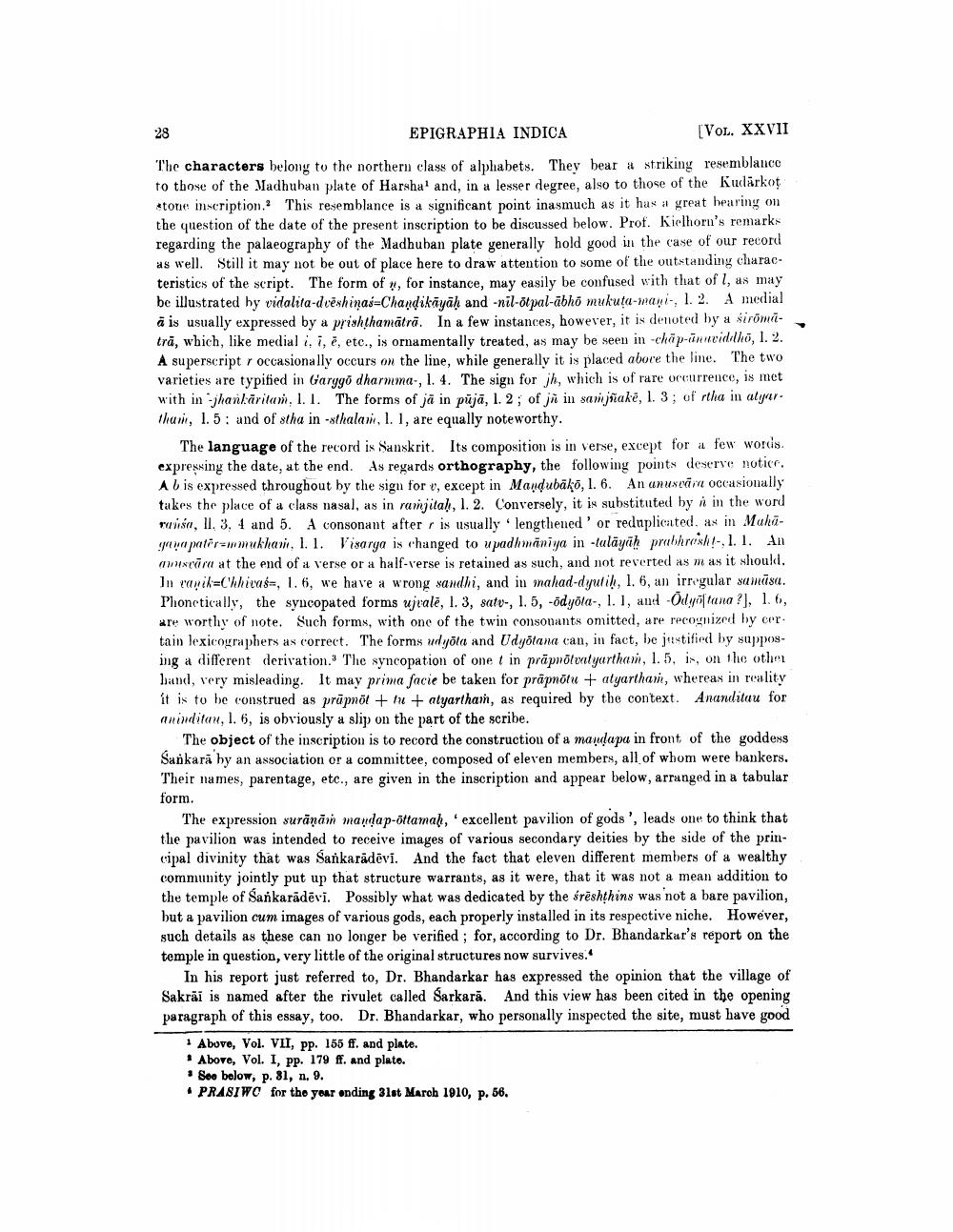________________
EPIGRAPHIA INDICA
[VOL. XXVII
The characters belong to the northern class of alphabets. They bear a striking resemblanco to those of the Madhuban plate of Harsha' and, in a lesser degree, also to those of the Kudarkot stone inscription. This resemblance is a significant point inasmuch as it has a great hearing on the question of the date of the present inscription to be discussed below. Prof. Kielhorn's remarks regarding the palaeography of the Madhuban plate generally hold good in the case of our record as well. Still it may not be out of place here to draw attention to some of the outstanding characteristics of the script. The form of y, for instance, may easily be confused with that of l, as may be illustrated by vidalita-dvēshinas-Chandikāyāh and -nil-otpal-abho mukuta-wani, 1. 2. A medial à is usually expressed by a prishthamäträ. In a few instances, however, it is denoted by a siromitra, which, like medial i, i, e, etc., is ornamentally treated, as may be seen in -chap-īnnoidlho, 1. 2. A superscript r occasionally occurs on the line, while generally it is placed abore the line. The two varieties are typified in Garygo dharmma, 1. 4. The sign for jh, which is of rare occurrence, is met with in jhankäritam. 1. 1. The forms of jā in pūjā, 1.2 ; of ji in savijake, I. 3; of rtha in atyurthai, 1.5: and of stha in -othalani, I. 1, are equally noteworthy.
The language of the record in Sanskrit. Its composition is in verse, except for a few words. exprenning the date, at the end. As regards orthography, the following points deserve notice, Abis expressed throughout by the sign for v, except in Mandubāko, 1. 6. An unustara occasionally takes the place of a class nasal, as in ramjitah, 1. 2. Conversely, it is substituted by i in the word win, II. 3. 4 and 5. A consonant after r is usually lengthened ' or reduplicated, as in Mahawapatero mukhan. 1.1. Visarga is changed to upadhmaniya in -lulāyāh prabhrosh!., 1.1. An
tvira at the end of a verse or a half-verse is retained as such, and not reverted as mas it should. In rail=Chhivass, 1.6, we have a wrong sandhi, and in mahad-dyutih, 1.6, an irregular sumisa. Phonetically, the syncopated forms ujvalē, I. 3, satu-, 1.5, -öd yola-, I. 1, and Odystana?], 1.6, are worthy of note. Such forms, with one of the twin consonants omitted, are recognized by cor. tain lexicographers as correct. The forms udyola and Udyotana can, in fact, be justified by supposing a different derivation. The syncopation of one t in prāpnõlvatyartham, 1.5, is, on the other hand, very misleading. It may prima facie be taken for prāpnētu + atyartham, whereas in reality it is to be construed as prūpnol + tu + atyarthaí, as required by the context. Ananditau for aninditaw, 1. 6, is obviously a slip on the part of the scribe.
The object of the inscription is to record the construction of a mawlapa in front of the goddess Sankara hy an association or a committee, composed of eleven members, all of whom were bankers. Their names, parentage, etc., are given in the inscription and appear below, arranged in a tabular form.
The expression surānā mayda p-ottamal, excellent pavilion of gods', leads one to think that the pavilion was intended to receive images of various secondary deities by the side of the principal divinity that was Sankarádovi. And the fact that eleven different members of a wealthy community jointly put up that structure warrants, as it were, that it was not a mean addition to the temple of Sankarādēvi. Possibly what was dedicated by the śrèshthins was not a bare pavilion, but a pavilion cum images of various gods, each properly installed in its respective niche. However, such details as these can no longer be verified; for, according to Dr. Bhandarkar's report on the temple in question, very little of the original structures now survives."
In his report just referred to, Dr. Bhandarkar has expressed the opinion that the village of Sakrai is named after the rivulet called Sarkară. And this view has been cited in the opening paragraph of this essay, too. Dr. Bhandarkar, who personally inspected the site, must have good
1 Above, Vol. VII, PP. 155 ff. and plate. • Above, Vol. I, pp. 179 ff. and plato. • Seo below, p. 81, n. 9. • PRASIWO for the year ending 31st March 1910, p. 56.




